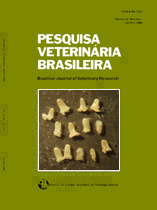 |
|
|
|
Year 2014 - Volume 34, Number 4
|

|
Beta-lactamase detection in Staphylococcus aureus and coagulase-negative Staphylococcus isolated from bovine mastitis, 34(4):325-328
|
ABSTRACT.- Robles B.F., Nóbrega D.B., Guimarães F.F., Wanderley G.G. & Langoni H. 2014. Beta-lactamase detection in Staphylococcus aureus and coagulase-negative Staphylococcus isolated from bovine mastitis. Pesquisa Veterinária Brasileira 34(4):325-328. Departamento de Higiene Veterinária e Saúde Pública, Faculdade de Medicina Veterinária e Zootecnia, Universidade Estadual Paulista, Distrito de Rubião Junior s/n, Botucatu, SP 18618-900, Brazil. E-mail: hlangoni@fmvz.unesp.br
The objectives of the study were to evaluate the presence/production of beta-lactamases by both phenotypic and genotypic methods, verify whether results are dependent of bacteria type (Staphylococcus aureus versus coagulase-negative Staphylococcus - CNS) and verify the agreement between tests. A total of 200 bacteria samples from 21 different herds were enrolled, being 100 CNS and 100 S. aureus. Beta-lactamase presence/detection was performed by different tests (PCR, clover leaf test - CLT, Nitrocefin disk, and in vitro resistance to penicillin). Results of all tests were not dependent of bacteria type (CNS or S. aureus). Several S. aureus beta-lactamase producing isolates were from the same herd. Phenotypic tests excluding in vitro resistance to penicillin showed a strong association measured by the kappa coefficient for both bacteria species. Nitrocefin and CLT are more reliable tests for detecting beta-lactamase production in staphylococci. |
| |
|
|
| |
|
 |